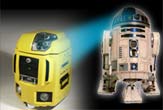Robots of the Future: Soft and Flexible

Unlike C-3PO's hard, metallic body or the Terminator's living tissue over a metal endoskeleton, robots of the future may be entirely soft-bodied.
A new research initiative is aiming to make robots mushier and more like animals in order to improve their flexibility and usefulness in areas ranging from medicine to space exploration.
While automated, anthropomorphic, metal-edged machines today are useful in many situations, such as manufacturing and medical procedures, their capabilities are limited compared to some cuddly—and not-so-cuddly, but still-squashable—living things
"Many machines incorporate flexible materials at their joints and can be tremendously fast, strong and powerful, but there is no current technology that can match the performance of an animal moving through natural terrain," said Barry Trimmer, co-director of the Biomimetic Technologies for Soft-bodied Robots project at Tufts University.
- Real Robots: Vote for Your Favorite
Machine vs. Nature
One of the fundamental differences between machines and animals is the material of which they are made, said Trimmer, who is heading up the soft-robot initiative.
"A major characteristic that distinguishes man-made structures from biological ones is the preponderance of stiff materials," he said. "In contrast, living systems may contain stiff materials such as bone or cuticle, but their fundamental building blocks are soft and elastic."
Get the world’s most fascinating discoveries delivered straight to your inbox.
In a soft-bodied organism such as a caterpillar, joints don’t restrict the animal’s movements; the caterpillar is free to bend or crumple as needed, in any direction.
In order to develop a control system for a soft-bodied robot, Trimmer is studying the neural circuitry that allows caterpillars to control this movement with their simple brains.
While strides have been made in developing soft materials for robots, "it is very hard to make soft devices that move around and can be precisely controlled," said Soft-bodied Robots project co-director David Kaplan. "This is the fundamental reason why robots currently move like robots instead of lifelike animals."
More Versatile
Developing robots with more fluid movements would allow them to climb textured surfaces, crawl along wires, or burrow into confined spaces.
"Soft-bodied robots could make many dangerous surgeries much safer and less painful," Trimmer said. "They could also be used by NASA to repair space stations by reaching places that astronauts can’t, perform more complicated tasks in industry that require flexibility of movement, help in hazardous environments like nuclear reactors and landmine detection, and squeeze more efficiently into tight spaces."

Andrea Thompson is an associate editor at Scientific American, where she covers sustainability, energy and the environment. Prior to that, she was a senior writer covering climate science at Climate Central and a reporter and editor at Live Science, where she primarily covered Earth science and the environment. She holds a graduate degree in science health and environmental reporting from New York University, as well as a bachelor of science and and masters of science in atmospheric chemistry from the Georgia Institute of Technology.


